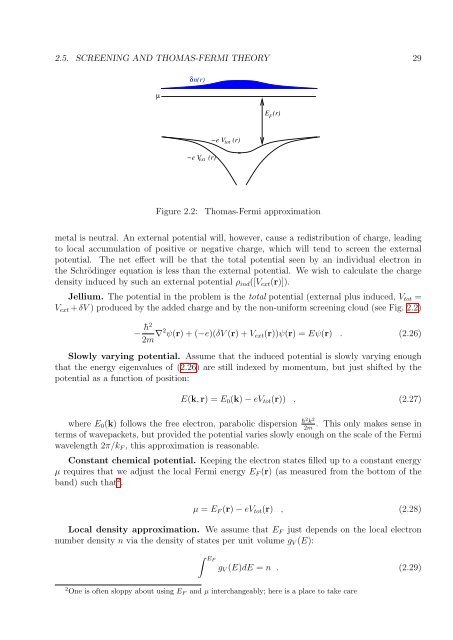Set of supplementary notes.
Set of supplementary notes.
Set of supplementary notes.
You also want an ePaper? Increase the reach of your titles
YUMPU automatically turns print PDFs into web optimized ePapers that Google loves.
2.5. SCREENING AND THOMAS-FERMI THEORY 29<br />
µ<br />
δn(r)<br />
E (r)<br />
F<br />
−e V (r) ext<br />
−e V (r)<br />
tot<br />
Figure 2.2:<br />
Thomas-Fermi approximation<br />
metal is neutral. An external potential will, however, cause a redistribution <strong>of</strong> charge, leading<br />
to local accumulation <strong>of</strong> positive or negative charge, which will tend to screen the external<br />
potential. The net effect will be that the total potential seen by an individual electron in<br />
the Schrödinger equation is less than the external potential. We wish to calculate the charge<br />
density induced by such an external potential ρ ind ([V ext (r)]).<br />
Jellium. The potential in the problem is the total potential (external plus induced, V tot =<br />
V ext + δV ) produced by the added charge and by the non-uniform screening cloud (see Fig. 2.2)<br />
− h¯ 2<br />
2m ∇2 ψ(r) + (−e)(δV (r) + V ext (r))ψ(r) = Eψ(r) . (2.26)<br />
Slowly varying potential. Assume that the induced potential is slowly varying enough<br />
that the energy eigenvalues <strong>of</strong> (2.26) are still indexed by momentum, but just shifted by the<br />
potential as a function <strong>of</strong> position:<br />
E(k, r) = E 0 (k) − eV tot (r)) , (2.27)<br />
where E 0 (k) follows the free electron, parabolic dispersion h¯2k 2<br />
. This only makes sense in<br />
2m<br />
terms <strong>of</strong> wavepackets, but provided the potential varies slowly enough on the scale <strong>of</strong> the Fermi<br />
wavelength 2π/k F , this approximation is reasonable.<br />
Constant chemical potential. Keeping the electron states filled up to a constant energy<br />
µ requires that we adjust the local Fermi energy E F (r) (as measured from the bottom <strong>of</strong> the<br />
band) such that 2 .<br />
µ = E F (r) − eV tot (r) , (2.28)<br />
Local density approximation. We assume that E F just depends on the local electron<br />
number density n via the density <strong>of</strong> states per unit volume g V (E):<br />
∫ EF<br />
gV (E)dE = n . (2.29)<br />
2 One is <strong>of</strong>ten sloppy about using E F and µ interchangeably; here is a place to take care








